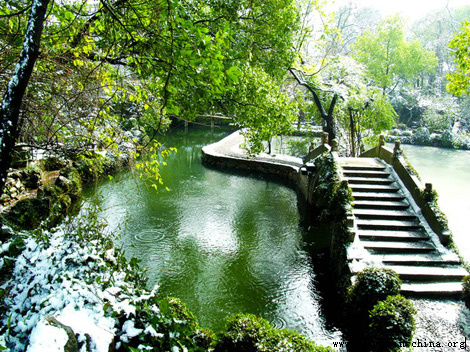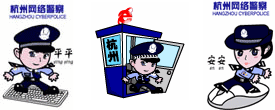| Home > China Feature |
Wushu and Science
A part of Chinese traditional culture, wushu is in many ways associated with the physical and social sciences. Following is an article written by Li Shixin, associate professor of wushu at Beijing University, on the relations of taijiquan, a major form of wushu, with mechanics, philosophy and other branches of learning. Taijiquan emphasizes the need to overcome hardness with softness and to win victory by artful means rather than by brute force. The "softness" and "artfulness" here imply an ingenious applicaton of force or, in mechanics phraseology, the use of minimum force for performing maximum work. This is particularly manifest in taiji tuishou ("push hands") duels, which are basically contests of strength but whose outcomes are not determined by strength alone. A person who is inferior in strength is sure to lose a bout if he makes it a contest of power, but may emerge victorious if he knows how to use his force cleverly. Some taijiquan classics describe the art of taijiquan in terms of "silk reeling power," something that is constantly in circular motion. As far as the shape and posture of the performer are concerned, his trunk, legs and arms are all naturally curved to form a flexible whole that can react to external forces with a high degree of adaptability, now yielding to an incoming force while neutralizing or deflecting it, now launching an attack by concentrating its own forces on a single point, or, as is the way with an experienced fighter, by "borrowing" the strength of the incoming force to accomplish the feat of "overthrowing a weight of one thousand catties with four ounces." Taijiquan is performed with the arms and hands moving in curves. As we know, anything that collides with an object that is moving in a curve will be deflected, thus reducing the impact to varying degrees. That is why one can nullify the strength of an attack more effectively with circular moves than with linear counterblows. This is also the reason why a person skilled in taiji techniques can beat an opponent with superior physical strength. Of course, while we underline the advantages of circular moves, we should never go to the extremes in using them. As the taiji maxims go, "Conserve your energy with circular moves before suddenly releasing it in a straight direction," and "Store up energy like drawing a bow, and release it like shooting an arrow." Generally speaking, one who is on the defence employs a lot of circular moves to meet and neutralize oncoming forces; but to stage an attack one has to collect one's strength to deliver a straight blow from close in so as to achieve a most powerful effect. Taijiquan movements are performed about the longitudinal, lateral, sagittal and numerous oblique axes -- all in a well-coordinated manner. An accomplished taiji performer may not be a physicist, but in practice he must be applying a lot of mechanical principles, either consciously or unconsciously. Taijiquan and Ancient Chinese Philosophy The word "taiji" first appeared in the Book of Changes (I Ching) and was later interpreted by well-known scholars like Zheng Xuan (127-200) of the later Han period and Kong Yingda (574-648) of the Tang Dynasty as the primordial qi that conglomerated in the universe before heaven and earth separated. Zhou Dunyi (1017-1073), a philosopher of the Northern Song period, wrote in his Treatise on the Taiji Diagram: "Wuji gives rise to taiji. Taiji in motion generates yang and extreme motion begets stillness which generates yin. Extreme yin, in turn, results in motion. In this way, motion and stillness are locked in reciprocal causation." The authoritative book Shanxi's Wang Zongyue on Taijiquan says: "Taiji was born of Wuji and is the mother of yin and yang." A Classical Record of Taijiquan, also an authoritative work, says: "The two aspects of taiji include heaven and earth, yin and yang, closing and opening, motion and stillness, softness and hardness, bending and stretching, coming and going, advancing and retreating, life and death...." These expositions about the opposition, unity and interaction between yin and yang have provided the theoretical basis for taijiquan. Application of strength in taijiquan, for instance, is such that the movements appear to be slow and gentle but are actually charged with powerful force -- just like a steel rod wrapped in cotton. Yin and yang are inseparable from each other; as extreme yin becomes yang and extreme yang becomes yin, the two transform into each other all the time. A similar relationship exists between emptiness and solidity in taijiquan movements: the two opposing aspects, coexisting in a single entity, are interdependent and interpenetrable, with each transforming itself into the other all the time. In fact, all taijiquan movements contain a unity of opposites: advance and retreat, upward and downward, slow and fast, stretching and bending, opening and closing, forward and backward, right and left, releasing and withdrawing, rise and fall, inhale and exhale, pull and push.... Such a dialectical relationship also exists between motion and stillness in taijiquan exercise. There is stillness in motion inasmuch as physical movements are meant to induce mental calmness during exercise. Of course, motion is absolute and stillness is only relative. For one thing, taijiquan exercise always requires one to sink one's qi down to the dantian region in the lower abdomen. Such an effort is regarded as a kind of motion of a high order. The theory of taiji, with all its implications about the transformation of yin and yang and their contradiction and unity, is explained in writing in Lao Zi's The Classic of the Way and Its Power (Tao Teh Ching) and graphically described in Zhou Dunyi's Treatise on the Taiji Diagram. These simple yet profound philosophical ideas form the theoretical basis of taijiquan and serve as the guiding principles for the performance of all kinds of taiji movements. To the minds of some Westerners, Oriental culture is a baffling mystery, and so is the Chinese art of taijiquan with its indescribable charm and grace. For them to appreciate the true value of taijiquan, it is necessary to know more about the philosophical ideas underlying it. Taijiquan and Ancient Arts of Health Keeping Ancient methods of maintaining health may be divided into two main categories: static and dynamic, the distinction being whether or not physical movements are involved. Exercises of both categories can be dated back to very early times. A historical record of the static exercise was found in an inscription on a piece of jade belonging to the Warring States Period (475-221 BC). Entitled "On the Circulation of Qi," it reads: "This calls for a round of deep breathing. Draw a deep breath and conduct it downward for storage, extension, fixation and consolidation. Then the qi will grow up like a sprout and circulate in your body until it reaches the top of the head. Thus, you are identifying yourself with heavenly essence up above and with earthly essence down below. One who goes along with this law of Nature will live, otherwise one will die." The method described here was used by the ancients who lived in harsh conditions and whose muscles and bones tended to shrivel from the damp cold and scorching heat of the changing weather. Promoting the circulation of blood and qi, the exercise helped enhance man's adaptability to the environment and improve his health. Exponents of the static method of health keeping appeared galore in different periods. Lao Zi, a great thinker born about 600 BC and founder of Taoism, maintained that regular practice of the qi-circulation exercise would unblock the flow of blood, keep the body and limbs supple and build up resistance to diseases. Guan Zi (?-645 BC), a well-known statesman of the Spring and Autumn Period, pointed out that in performing the exercise, one must keep calm, cultivate concentration and purge one's mind of distracting thoughts, so as to sink qi down to the lower abdomen. Zhuang Zi (c369-286 BC), a great interpreter of Taoism, considered quiescence as a way of curing ailments. Descriptions of nourishing qi in quietude and conducting the flow of qi with mental power can be found in abundance in ancient Chinese writings. Principles of Life Force, a classical book on static qigong, describes how qi circulates through various parts of the human body: "The internal qi comes bubbling up from the dantian region (below the abdomen), goes through the left ribs and left shoulder, rises to the back of the left ear and further up to the xuanguan point between the eyebrows to complete an act of inhalation. Moments later, the qi at the xuanguan point falls to the back of the right ear and further down to the right shoulder and the right ribs before going back to the dantian region to complete an act of exhalation." Such static methods of health keeping have been incorporated into taijiquan exercises. As stated in taijiquan manuals, a taiji exerciser must relax his abdomen, control his breathing, keep his mind quiet, his chin tucked in and head lifted, and let his qi sink down to dantian so as to hold the body in such a way that it is "empty at the top and solid at the base" -- a posture that allows smooth breathing and alleviates tension. These requirements are very much the same as those which have to be fulfilled in ancient static exercises for health keeping. An accomplished taiji boxer knows how to use his mental power to direct his intrinsic qi to various parts of the body so as to make it impenetrable to attacks. He is also able to direct the qi to that part of the body which he uses to attack so as to make his assaults more powerful. Taijiquan also claims kindred with "daoyin," an ancient form of dynamic health-building exercise that combines breathing with physical movements. The earliest example of daoyin exercises was found in the figures drawn on silk scrolls unearthed from a Han Dynasty tomb in Changsha, capital of Hunan Province. These drawings provide us with valuable data for the study of dynamic health-oriented exercises prevailing in ancient times. Many daoyin exercises were modelled after animal movements. Zhuang Zi, a book written by the ancient philosopher of the same name, says that "the bear climbs up a tree and the bird flutters its wings in pursuit of longevity." Down through the ages the art of daoyin gradually developed into a complete system of health building methods. Hua Tuo (?-208 BC), a celebrated physician of the late Han Dynasty, created the "five-animal play," a set of fitness-keeping exercise which imitated the movements of the tiger, dear, bear, ape and bird. This was later developed into a new set called "seven-animal play." From the Tang Dynasty (618-907) on, there appeared many other variants of doayin exercises, the most notable ones being baduanjin (brocade exercises in eight forms) and yijinjing (exercises for limbering up the tendons). As a form of wushu, taijiquan assimilates the essence of both the static and dynamic exercises. Thus the taijiquan classic Thirteen-Form Formula clearly states that in taiji exercises "there is motion in stillness," "the intrinsic qi flows through the whole body without a hitch," "the abdomen is relaxed and clear but full of soaring qi," and "all movements of bending and stretching, opening and closing, are executed with ease." Combining the features of ancient static and dynamic exercises, the taiji movements are slow and gentle, without exerting force to the utmost, the purpose being to activate the organism, to promote the circulation of qi and blood, and to achieve harmony between yin and yang, mental equilibrium and spiritual peace. As a development of ancient static and dynamic exercises, taijiquan has become a unique health-oriented system in its own right. It is a valuable asset belonging not only to the Chinese people; with its value gaining wider and wider appreciation, it will benefit more and more people in the rest of the world.
The Mechanics of Taijiquan
The famous principle of "using a force of four ounces to overthrow a weight of one thousand catties" in taiji combat, exaggerated as it sounds, contains much scientific truth.
Taijiquan is a time-honoured scientific way of maintaining physical and mental health. It is an art for strengthening man's organism, developing his intellect and ennobling his soul. Based on the theory of yin and yang and of the unity of man and Nature as expounded in ancient Chinese philosophy, it helps the self-actualization and physical and spiritual emancipation of man.
Taijiquan, as an excellent way of keeping fit, originates from ancient Chinese arts of health preservation.
Art
 more
moreChina Beijing International Diet ...
Recently, The hit CCTV documentary, A Bite of China, shown at 10:40 ...
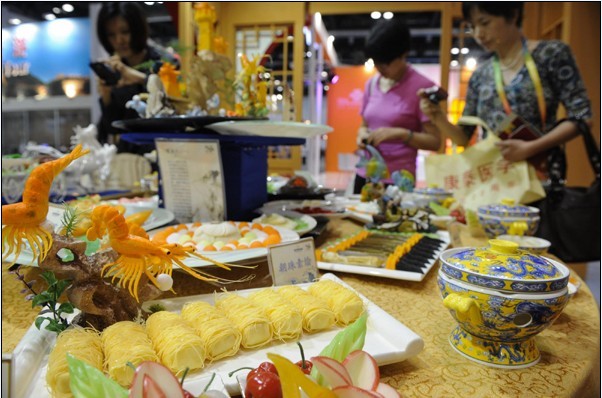
Exhibition of Ancient Chinese Jad...
At least 8,000 years ago, Chinese ancestors discovered a beautiful...
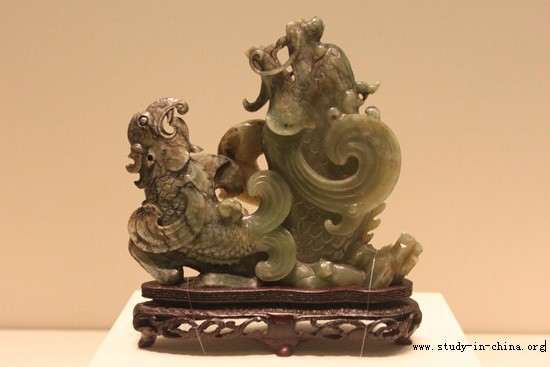
Longmen Grottoes
The Longmen Grottoes, located near Luoyang, Henan Province, are a tr...
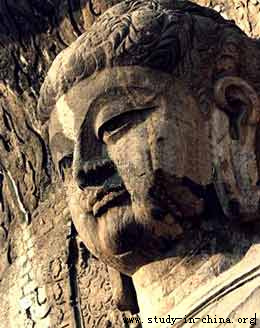
Custom
 more
moreWeb Dictionary
Martial Arts
Tai Chi Master Class Held in Moscow
MOSCOW, June 15, 2016 (Xinhua) -- Students learn from Shaolin ...
Celebriting 70 years' efforts in restoring Mogao...
Work is being carried out at the restoration site of cave No 98 a...
Hong Kong Children's Symphony performs in Seattle
Under the theme of Tribute to the Golden Age, a concert featuring a ...





 print
print  email
email  Favorite
Favorite  Transtlate
Transtlate 